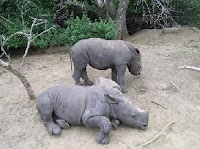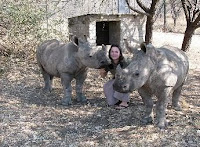Arriving at the location given by the lady, Brian noticed the poor little thing that was approx. 2½ months old, it looked in a bad state and before Brian could do anything it crawled under the fence into Kapama Reserve summoned by its mother’s desperate call. Brian realized the danger of trying to stop it and had to leave it be as he could not go further without trespassing on private property. Reluctantly they returned and Brian phoned the Reserve to let them know of the incident and that it would be best to put the baby out of its misery. There definitely was no chance of it living as he could see it was severely injured. On their return Jenny soon dozed off to sleep but Brian tossed and turned, not being able to get the baby leopard out of his mind and feeling bad that he did not get to it in time.
Sleep was soon broken, so it seemed, with another call at 5:30 that next morning from a desperate local farmer who found a trio of honey badgers that had moved onto his farm and they were killing his geese. Unfortunately Honey Badgers can cause devastation to poultry and honey farmers if given a chance.
Often we receive phone calls for “problem animals” whose quest for food takes them onto farm lands where they are not seen as welcome visitors. So it is with gratitude when a person contacts us to let us know when they have a problem and ask what can we do about it?
Once again Brian collected the necessary equipment and called a guide and volunteer students who were eager to assist and rushed over to survey the scene. We were greeted with an excited farmer and a rather ruffled feathered looking dead goose amongst the remaining few geese that were looking rather flustered. The farmer had been proactive and had set up a trap cage and had successfully managed to catch one of the badgers! The desperation in his voice on the phone was the fact that the badger was escaping!! The honey badger, a large male, was brought back to the rehab to await the arrival of his “partners in crime” who the farmer hoped would join him soon!
 We then set up our own cage trap which is ‘Badger Proof’ (to an extent) and this time the dead goose that had been found at the scene of the crime (see photo below) was placed within. Knowing what we knew about the honey badgers’ expertise in escape artistry, they would outshine Houdini definitely, so a specific cage trap had to be used to prevent the honey badger escaping once he had satisfied himself on the gourmet meal we had laid out for him.
We then set up our own cage trap which is ‘Badger Proof’ (to an extent) and this time the dead goose that had been found at the scene of the crime (see photo below) was placed within. Knowing what we knew about the honey badgers’ expertise in escape artistry, they would outshine Houdini definitely, so a specific cage trap had to be used to prevent the honey badger escaping once he had satisfied himself on the gourmet meal we had laid out for him.All that was left to do now was wait…! But we did not have to wait for very long! On the second night the temptation was just too much and the second of the Honey Badgers from the trio had taken the bait! Success!
He too was brought back to the rehab to join his ally. They have gone underground (literally speaking) and we do not see too much of them at the moment. They have been placed in one of the enclosures until we could find a suitable release spot for them.
Two safely in hand, one more to go:-
The third member of this trio is being slightly more evasive. The trap has remained empty for the last three nights. We hope that we can soon reunite this artful badger with his friends so that they may be relocated together to an area where they can dig, run and eat to their hearts’ content. But if not, the 2 will be released approx. 130km from here in on large Game Farm fitted with a transmitter so we can monitor their movements as well, which we are sure will be very interesting!
Until next time go well!








